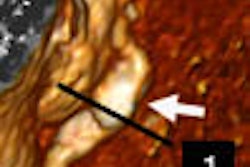VANCOUVER - Acute pelvic pain in women is a common emergency room complaint and the diagnoses for this condition are quite diverse. Most clinicians have a choice between imaging these patients with CT or ultrasound as a first-line diagnostic tool.
An analysis of nonpregnant females presenting with pelvic pain in an ER setting suggests that the modalities may be equal in their capability to determine the need for surgery in these patients.
"From the gynecologic standpoint, clinicians are most worried about ovarian torsion and gynecologic ascites because these may require emergent surgery," said Dr. Dawn Hastreiter in a presentation at this week's American Roentgen Ray Society (ARRS) meeting. "However, many general surgery conditions such as appendicitis and urinary systems stones can present as acute pelvic pain."
Hastreiter is from the University of Washington Harborview Medical Center in Seattle, and presented the results from a retrospective analysis of 157 women at her institution who underwent an abdomen/pelvis CT or pelvic ultrasound for acute pelvic pain between October 2002 and October 2004.
"Ultrasound has often been the preferred modality of imaging because of the lack of radiation, but there's been actually been no comparison of CT and ultrasound for acute pelvic pain," she said. "There are also no reports on how often CT and ultrasound are helpful in the diagnosis."
In 71 of the cases, the women first underwent a contrast-enhanced or noncontrast abdomen/pelvis CT on a GE Healthcare (Chalfont St. Giles, U.K.) four-, eight-, or 16-detector CT system. The remaining 86 cases had a pelvic ultrasound performed as their first diagnostic imaging exam. The average age of the women in the study was 32 ± 10 years, according to Hastreiter.
"The aim of the study was to determine the diagnostic performance of CT and ultrasound in acute pelvic pain, primarily in predicting the need for surgery," she said.
Abnormal findings were found in 70% and 65% of the initial CT scans and ultrasound studies, respectively. A second imaging study, either CT or ultrasound depending on the original diagnostic exam, was performed during the same hospitalization in 21% of the patients, Hastreiter said.
A subsequent CT scan changed the diagnosis in three of eight patients who had a negative ultrasound scan, with one patient requiring emergency surgery for appendicitis. An ultrasound exam changed the diagnosis in only one of 25 patients who first underwent a CT for pelvic pain, but the exam was considered to have better reflected the diagnosis in an additional five cases.
Imaging findings were diverse and included ovarian cysts, gynecologic masses, appendicitis, and normal studies, Hastreiter noted. A final diagnosis was obtained by CT or ultrasound in 80% (125) of the cases. In two cases, MRI provided the final diagnosis in a case of presumed pelvic metastases and another of lumbar epidural abscess.
In 20 of the 32 cases in which CT or ultrasound did not provide a final diagnosis, the patients were determined to have confirmed or presumed pelvic inflammatory disease or urinary tract infections. In these cases, in which pelvic pathology is more readily diagnosed by laboratory analysis or a clinical history and exam, Hastreiter suggested that the patients may be better served by having normal imaging procedures performed.
A total of 21 patients from the cohort had surgery performed between 0 and 220 days after presenting with acute pelvic pain. There were eight appendectomies, 11 gynecologic surgeries, and one urologic surgery. With respect to predicting the need for surgery, all imaging studies were categorized as true-negative, false-negative, true-positive, or false-positive.
"In predicting the need for surgery, the sensitivity and positive predictive value for both CT and US were above 0.80," Hastreiter said. "The specificity and negative predictive value for both were very high, greater than 0.97."
Hastreiter noted that her research team's positive predictive value for acute pelvic pain imaging with CT or ultrasound could be used as a comparison standard for other institutions to determine if they are overusing imaging. In addition, she suggested that pelvic ultrasound and CT are nearly equally effective in aiding in the diagnosis of acute pelvic pain, and that performing both imaging techniques in an emergency setting could be reserved for unclear cases.
"If you happen to get a CT and the patient has acute pelvic pain, a secondary ultrasound could be reserved for a large adnexal mass to help assess for torsion," she said. "And if you have a negative ultrasound and appendicitis is still on the table, get a CT."
By Jonathan S. Batchelor
AuntMinnie.com staff writer
May 3, 2006
Related Reading
3-tesla MR shows promise for abdominal, pelvic imaging, April 4, 2006
Pelvic view, single reader yield best results for measuring joint space in OA, December 9, 2005
US detection of endometrial mass aids RPOC diagnosis, September 8, 2005
PET superior to CT scan for evaluating vaginal carcinoma, July 8, 2005
Ultrasound helps identify adnexal mass as ectopic pregnancy, May 19, 2005
Copyright © 2006 AuntMinnie.com



















